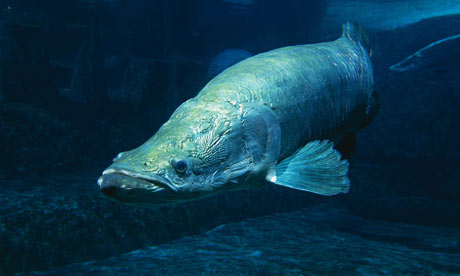
The arapaima needs to surface to breathe, which leaves it vulnerable. Photograph: Corbis
The arapaima, a giant Amazon river fish that can grow longer and heavier than a human adult, is at risk of extinction, according to a new study. Overfishing and errors in classification are believed to have left the world's largest scaled freshwater fish critically endangered.
A report in the Journal of Applied Ichthyology, a branch of zoology devoted to fish, said there were four sub-species of arapaima – not just one, as previously thought – and that they were under severe pressure from fishermen. Arapaima mature relatively late and need specific habitats to live and reproduce. The fish's size – it can grow to more than 2m and weigh over 200kg – and need to surface to breathe have left it vulnerable to harpoons and gill nets, said the authors, Leandro Castello of the Woods Hole Research Centre in Falmouth, Massachusetts, and Donald Stewart of the State University of New York. "They have the curse of being tasty and of having to breathe air," Castello told the BBC. Much of what is known about the arapaima, also known as pirarucu or paiche, is based on a taxonomic review conducted over 160 years ago.
The researchers analysed nearly all preserved museum specimens of supposed arapaima and found only one specimen of Arapaima gigas. The others are suspected to be closely related species. "Our new analyses indicate that there are at least four species of arapaima," said Castello. "So, until further field surveys of appropriate areas are completed, we will not know if Arapaima gigas is extinct or still swimming about."
Fishermen ignore regulations intended to manage stocks, he said, and there is a lack of data about population numbers. "The present situation may be one in which one species of arapaima is recovering in certain areas, while unrecognised species are going extinct."
Full Article: Guardian
A report in the Journal of Applied Ichthyology, a branch of zoology devoted to fish, said there were four sub-species of arapaima – not just one, as previously thought – and that they were under severe pressure from fishermen. Arapaima mature relatively late and need specific habitats to live and reproduce. The fish's size – it can grow to more than 2m and weigh over 200kg – and need to surface to breathe have left it vulnerable to harpoons and gill nets, said the authors, Leandro Castello of the Woods Hole Research Centre in Falmouth, Massachusetts, and Donald Stewart of the State University of New York. "They have the curse of being tasty and of having to breathe air," Castello told the BBC. Much of what is known about the arapaima, also known as pirarucu or paiche, is based on a taxonomic review conducted over 160 years ago.
The researchers analysed nearly all preserved museum specimens of supposed arapaima and found only one specimen of Arapaima gigas. The others are suspected to be closely related species. "Our new analyses indicate that there are at least four species of arapaima," said Castello. "So, until further field surveys of appropriate areas are completed, we will not know if Arapaima gigas is extinct or still swimming about."
Fishermen ignore regulations intended to manage stocks, he said, and there is a lack of data about population numbers. "The present situation may be one in which one species of arapaima is recovering in certain areas, while unrecognised species are going extinct."
Full Article: Guardian
No comments:
Post a Comment